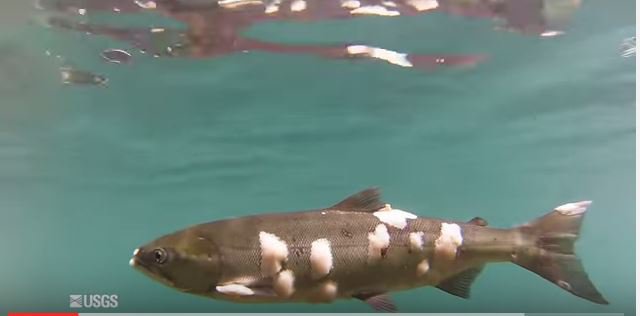Warm Water Wreaks Havoc on Columbia River Fish
- August 12, 2015
- John Harrison

Six words describe the state of the Columbia River in 2015 for salmon, steelhead, and sturgeon: Too hot, too early, too long.
The unusually warm June and July raised Columbia River water temperatures to lethal levels, and above, for weeks, coinciding with the peak of the migration for the most temperature-sensitive salmon, sockeye. Spring Chinook and steelhead, which migrate earlier in the year, also were affected, and fall Chinook, which are migrating now, likely will be affected, as well. Representatives of the four Northwest state fish and wildlife agencies, plus the U.S. Army Corps of Engineers and NOAA Fisheries, briefed the Northwest Power and Conservation Council at its August meeting.
Dan Rawding of the Washington Department of Fish and Wildlife said the number of sockeye counted crossing Bonneville Dam, the first dam inland from the ocean where fish can be counted, was the second-highest on record, more than 500,000 fish. But the number of these fish counted at McNary Dam, two dams and 146 miles upriver, was about 277,000. While inter-dam losses are normal, this year it appears that at least 100,000 more fish died than is normal in that reach, Rawding said. The primary culprit appears to be water temperatures that were consistently above 70 degrees – the highest and longest-duration ever recorded in July in the forebay of the dam. These aren’t record temperatures, just record early temperatures for a record long time, Rawding said. Prolonged water temperatures above 68 degrees are lethal for cold-water fish like salmon and trout.
Snake River sockeye, an endangered species, appear to have been hit hard by the warm water, said Paul Kline of the Idaho Department of Fish and Game. Extraordinary measures have been taken to protect them, including trucking fish from Lower Granite Dam to spawning grounds in central Idaho or to hatcheries. To date, only nine have arrived on their own at the spawning grounds compared to about 500 at this time last year, he said.
Sturgeon also have suffered. Tom Rien of the Oregon Department of Fish and Wildlife said 134 “oversized” sturgeon – large fish of spawning age - have been found dead in the Columbia. There are many possible causes for the die-off, he said, including prolonged exposure to warm water and gorging on dead sockeye. Dead spring Chinook salmon and steelhead also have been found in the Columbia, notably downstream of Bonneville Dam, Rien said.
In Montana, Matt Boyer of the state Department of Fish, Wildlife & Parks, said warm water triggered a number of responses to protect the state’s wild trout and bull trout. These included time-of-day fishing restrictions and efforts to reduce irrigation withdrawals to help cool rivers and streams.
Ritchie Graves of NOAA Fisheries, the federal agency that implements the Endangered Species Act for salmon, said Northwest fishery managers coordinated their efforts well this year in response to the extraordinary conditions and plan to issue a report this fall. Graves said it is scientifically impossible to tell whether the 2015 conditions were an aberration or a harbinger of future summers, a new normal. “Personally, I think we need to plan for events like this to recur,” he said.



